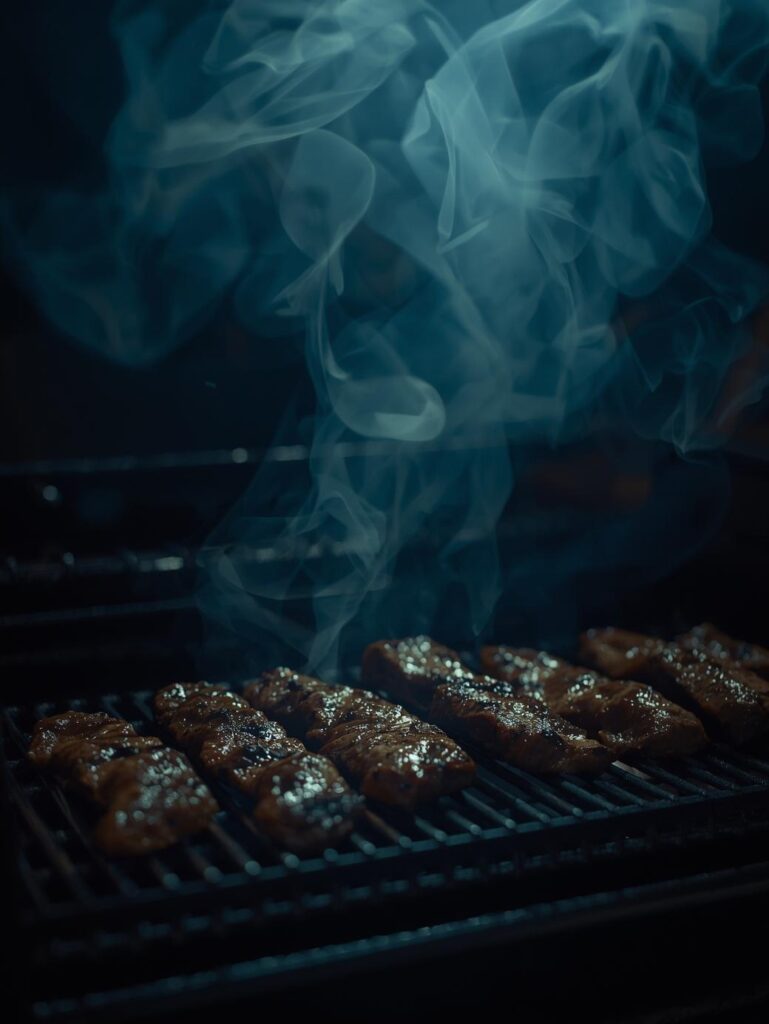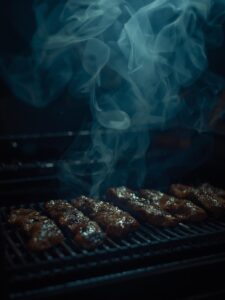Expert’s Note: This guide is part of our essential BBQ Equipment Maintenance Series. A well-maintained smoker is the foundation of legendary barbecue, in any season.
COLD WEATHER SMOKER CARE: THE ULTIMATE WINTER BBQ GUIDE
“The true pitmaster isn’t defined by a sunny day. They are defined by their ability to harness the flame when the wind howls and the snow falls. Winter doesn’t end your BBQ season; it simply forges a better BBQ warrior.”
Cold Weather Smoker Care – The Meat Master USA
Download our free Cold Weather Cooking Quick-Reference Sheet for your grill station.
When the temperature plummets, many pitmasters sadly tarp their smokers and retreat indoors until spring. They are missing out on some of the most rewarding BBQ of the year. The cold, dense air can produce incredibly moist and flavorful meat, and there’s a profound satisfaction in conquering the elements.
However, firing up your smoker in freezing conditions without preparation is a recipe for frustration. Your smoker will burn through fuel at an alarming rate, struggle to reach and hold temperature, and its components are under unique stress. This isn’t a time for guesswork; it’s a time for strategy.
This ultimate guide will equip you with the knowledge and techniques to not only protect your valuable equipment during the winter months but to master it. We will cover essential cold-weather modifications, strategic cooking adjustments, and critical safety practices to ensure you can produce championship-level BBQ all year long.
❄️ THE COLD REALITY: HOW WINTER AFFECTS YOUR SMOKER
To conquer the cold, you must first understand the enemy. Winter presents three main challenges to your smoker.
⚙️ The Physics of Cold Weather Smoking:
- Heat Sink Effect: Your smoker is a massive piece of cold metal. It takes significantly more energy (fuel) to heat it up from 20°F than from 70°F. The metal itself acts as a “heat sink,” constantly drawing warmth away from the cooking chamber.
- Increased Convection: Cold, dense air sucks heat from every seam, vent, and surface of your smoker. The greater the temperature difference between the inside and outside, the faster heat escapes. Wind exacerbates this dramatically, stripping heat away like a thief.
- Fuel Inefficiency: Whether it’s charcoal, wood, or pellets, your fuel must work overtime. Combustion can be less efficient in cold air, and a significant portion of the energy produced is wasted on simply fighting the ambient cold instead of cooking your food.
🎯 The Impact on Your Cook:
-
- Longer Pre-heat Times: Don’t expect to be ready in 15 minutes. Give your smoker at least 50-100% more time to reach a stable target temperature.
Erratic Temperature Swings: Your smoker’s thermostat will be in a constant battle, leading to wider temperature fluctuations if not properly managed.
- Extended Cook Times: A brisket that takes 12 hours in summer can easily take 14-16 hours in winter. The meat itself is starting from a colder state, and the cooking environment is less efficient.
🛡️ PREPARING FOR BATTLE: THE COLD-WEATHER SMOKER ARMOR KIT
Before you even light a fuse, these proactive steps are non-negotiable for efficiency and safety.
🔥 The Welding Blanket: Your #1 Weapon
What it is: A fiberglass-woven blanket designed for extreme heat (often rated to 1000°F+). It is the single most effective upgrade for winter smoking.
How to Use It: Drape it over the main body of your smoker, avoiding direct contact with the stack and any hot vents. Use magnetic hooks or bungee cords to secure it against the wind.
Why It Works: It creates a layer of insulated, dead air space around the metal, drastically reducing heat loss and protecting your smoker from wind chill. It can cut your fuel consumption by 30% or more.
🔧 Thermal Gaskets & Seals
Heat escapes through the path of least resistance. If you haven’t already, install high-quality, high-temperature gasket tape around your smoker’s door. A tight seal prevents precious heat and smoke from leaking out, forcing it to circulate around your meat instead.
🧊 The Thermal Blanket (For Pellet Grills)
Many pellet grill manufacturers sell custom-fitted insulating blankets. If you plan to smoke regularly in cold weather, this is a worthwhile investment. It serves the same purpose as a welding blanket but is tailored for a perfect, safe fit for your specific model.
📍 Strategic Positioning
Wind Block: Position your smoker so a wall, fence, or vehicle blocks the prevailing wind. Even a simple piece of plywood can serve as an effective windbreak.
Safety First: Never use a smoker in an enclosed space like a garage, even with the door open. Carbon monoxide is a silent, deadly killer. Always ensure absolute ventilation.
Pro Tip: Keep your fuel (pellets, charcoal, wood chunks) stored indoors until you need it. Cold, damp fuel burns poorly and inefficiently. Having fuel at room temperature ensures a cleaner, hotter fire from the start.
🎛️ MASTERING THE FIRE: COLD WEATHER COOKING STRATEGIES
Your technique must adapt to the conditions. Here’s how to adjust your approach.
🌡️ The “Temperature Bump” Rule
For every 10-15°F the ambient temperature drops below 40°F, plan to increase your smoker’s set temperature by 25°F. You are compensating for the increased heat loss. For example, if you normally smoke a pork shoulder at 225°F and it’s 25°F outside, set your smoker to 250°F. This helps achieve a similar internal cooking environment and can help normalize cook times.
⏱️ Patience is a Virtue: The Extended Pre-heat
Give your smoker a “warm-up” period. Start it at least 45-60 minutes before you plan to cook. Let it come to temperature and hold it there for 15-20 minutes. This ensures the entire cooking chamber—grates, walls, and all—is fully heat-soaked and stable.
🚫 THE LID-LOCK RULE
This is the golden rule of winter BBQ. If you’re looking, you ain’t cooking. Every time you open the lid, you release a massive amount of heat and moisture, which can take 10-15 minutes to recover in cold weather. Trust your probes and only open the lid when absolutely necessary (e.g., to wrap meat or replenish wood chunks).
💧 The Humidity Factor
Cold air holds less moisture. This can lead to a drier cooking environment, potentially resulting in a tougher bark or drier meat. Consider using a water pan placed near the heat source to introduce moisture and help stabilize the internal temperature.
🥩 THE MEAT OF THE MATTER: PREPPING PROTEIN FOR THE COLD
Your meat needs special consideration before it even touches the grates.
🚫 Never Start with Frozen or Ice-Cold Meat
Taking a refrigerated (38°F) brisket and putting it into a 250°F smoker is a thermal shock that will drastically extend your cook time. For large cuts like brisket and pork shoulder, let them sit on the counter for 60-90 minutes before cooking to take the deep chill off. The goal is to get it closer to 50-55°F, not room temperature.
🧣 Keep Your Meat Cozy
Once your meat is on the smoker, the cold metal grates can “steal” heat from the surface of the meat. Some pitmasters pre-warm their wire racks (if using) by placing them near the smoker during the pre-heat phase.
🚨 WINTER SMOKER SAFETY: A NON-NEGOTIABLE GUIDE
The risks are higher in winter. Do not cut corners.
🧯 Fire Extinguisher & Hose Check
Always have a fire extinguisher rated for grease fires (Class B) within easy reach. Ensure your garden hose is not frozen and is accessible. Snow on the ground is not a reliable fire suppressant.
🌫️ Beware of Ice & Snow Hazards
Clear a wide, safe area around your smoker of snow and ice to prevent slips and falls when handling hot, heavy food. Be vigilant about where melting snow or ice drips, as it can cause thermal shock to your smoker or create electrical hazards for pellet grills.
🔌 Pellet Grill Electrical Safety
Keep your pellet grill’s power cord and control box clear of snow and water. Use a heavy-duty, outdoor-rated extension cord if needed. Never run a cord through snow or a puddle.
🍖 Food Safety in the Cold
Just because it’s cold outside doesn’t mean you can ignore food safety rules. The “Danger Zone” (40°F – 140°F) still applies. Use a dedicated meat thermometer to track internal temperature and move food through the danger zone as efficiently as possible.
🔧 THE POST-COOK WINTER MAINTENANCE RITUAL
How you treat your smoker *after* the cook is just as important for its longevity.
🚫 The “No Hard Scrape” Rule
When your cook is done and you turn off the smoker, do not immediately scrape the grates. The extreme temperature difference between the hot steel and the freezing air can cause the metal to become brittle and potentially crack. Let the smoker cool down gradually to ambient temperature before attempting to clean the grates.
💨 Managing Moisture & Condensation
As the smoker cools, moisture from the air and the cooking process will condense on the cold metal interior. This is a prime cause of rust. – After it’s cool: Wipe down the entire interior with a dry cloth or paper towel to remove condensation. – Leave the Lid Open: After wiping it down, prop the lid open an inch or two for a few hours to allow any remaining moisture to evaporate completely before closing it up for storage.
🛡️ The Final Winter Storage Check
Before covering your smoker, ensure it is: – Completely Cool: Never cover a warm smoker. – Perfectly Dry: Inside and out. – Protected: Use a waterproof, fitted cover. A tarp can trap moisture underneath, promoting rust.
🎯 Cold Weather Smoker Care Quick-Check List
| Stage | Critical Action |
|---|---|
| Preparation | Get a welding blanket, check gaskets, create a windbreak, bring fuel indoors. |
| Ignition | Allow 45-60 min for pre-heat. Let the smoker fully heat-soak. |
| Cooking | Bump temp by 25°F, obey the LID-LOCK RULE, use a water pan, keep meat warm before cooking. |
| Safety | Have a fire extinguisher, clear ice/snow, protect electrical cords. |
| Clean-Up | Let it cool naturally, wipe down condensation, ensure it’s dry before covering. |
🏁 CONCLUSION: EMBRACE THE COLD
Winter is not your smoker’s enemy; it is your training ground. The challenges it presents will force you to understand your equipment more deeply, hone your fire-management skills, and practice a level of patience that translates to incredible BBQ in any season.
The pitmasters you admire don’t pack up when the first frost hits. They layer up, fire up, and prove their mastery. By following this guide, you are equipped to do the same. You’ll save fuel, protect your investment, and most importantly, produce succulent, smoky feasts that taste all the sweeter for the conditions in which they were born.
Your mission is clear: Do not let your smoker hibernate. Pick a weekend, forecast be damned, and commit to a winter cook. A pork butt is a perfect candidate. Apply these techniques and taste the victory for yourself.
📚 Related BBQ Topics
- Pellet Smoker Troubleshooting Guide – Fix common cold-weather issues
- The Ultimate Meat Temperature Guide – Hit your targets perfectly, every time
- BBQ Equipment Maintenance Series – Keep your gear in championship condition
- Best Woods for Smoking Meat – Choose the right flavor for your winter feast
Ready to Conquer Winter?
Don’t let the cold stop your smoke. Master your equipment in any condition and become a year-round pitmaster.



